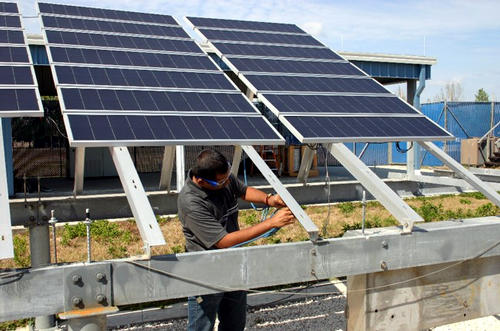feed-in tariffs
-
India’s 1.1 billion move to feed-in tariffs
Cross-posted from Wind-Works. The world’s largest single political jurisdiction to date, India, has made a strategic move to use a comprehensive system of feed-in tariffs to develop its renewable energy potential. China had previously announced feed-in tariffs for wind energy only. The country is expected to reveal feed-in tariffs for solar energy later this year. […]
-
Feed-in rates: a hard sell
I really feel for the renewable energy activists in the U.S. who are trying to get the most successful policy in the world, feed-in tariffs (FITs), implemented. The problem in the U.S. is, ironically, that so many U.S. renewables advocates actually oppose the idea (because it wasn’t theirs), and even now that everyone seems to […]
-
Ontario launches comprehensive system of feed-in tariffs
Ontario, on Thursday, launched the province’s long-awaited program of feed-in tariffs in response to its ground-breaking Green Energy Act. Ontario Premier Dalton McGuinty, Minister of Energy and Infrastructure George Smitherman, and Minister of the Environment John Gerretsen made the announcement against the iconic backdrop of Toronto’s cooperatively-owned wind turbine. This was the last in a […]
-
Does the Wall Street Journal employ anyone who understands energy markets?
Actually, I think they do. I think Keith Johnson knows quite a bit about energy markets. Which makes this hit job on solar subsidies, published before the Senate considers national renewable energy legislation, so disturbing. After chronicling the problems of the Spanish solar industry, the article goes on to say: “Clean-energy skeptics, however, point to […]
-
California proposes new program for 1 GW of renewables
The California Public Utilities Commission issued a new proposal today designed to significantly increase the amount of solar energy installed in the state. It is kind of like a feed-in tariff, but different. Call it a feed-in tariff v2.0. The proposed program would require utilities to purchase electricity from mid-size solar and other renewable energy […]
-
North American feed-in tariff policies take off
Gainesville’s feed-in tariff program is limited to 4 megawatts of solar PV each year. The program is already fully subscribed through 2015 — a 24-megawatt commitment.Photo courtesy U.S. NRELClean energy advocates in Europe have long considered the feed-in tariff as an antidote to the industrial world’s fossil fuel dependency. Now, the United States and Canada […]
-
Vermont feed-in tariffs become law
Vermont’s feed-in tariff legislation became law at the end of business on May 27, 2009. H. 446 is the first legislation calling for a full system of advanced renewable tariffs in the US to pass the legislature and become law. The bill includes changes to Vermont’s Sustainably Priced Energy Enterprise Development Program (SPEED) that would […]
-
Energy storage, emissions hotspots, waste-to-fuel, and feed-in tariffs again
• I wish I was as funny as The Editors.
• Interesting: AEP, one of the most coal-heavy and change-resistant utilities on the planet, is experimenting with backyard energy storage systems.
• A good piece from the Center for Progressive Reform examines the risk of "hotspots" in a carbon cap-and-trade program. Of course there's no such thing as a carbon hotspot, but facilities that create carbon also tend to create co-pollutants, so it's a legitimate fear. Author Shana Jones has some ideas for how cap-and-trade could be crafted to avoid this danger.
• Ontario recently instituted a feed-in tariff program. What happened?
So many local wind and solar developers -- as well as homeowners looking to install photovoltaic panels -- applied for Ontario’s standard offer that the government’s 10-year target cap of 1,000 megawatts was exceeded within a year.
Said one energy analyst, "The lesson is that renewable energy technology was a lot more market-ready than the energy planners thought it was." Golly, I wonder if that's true in the U.S. too?
• Biofuels Digest has an interesting report on the promise of "waste-to-fuel" companies, which take municipal solid waste -- i.e., garbage -- and make biofuel out of it:
-
Feed-in tariffs, Chu off-message, MPG v. GPM, and the prospects for solar PV
I have about three months worth of unattended tabs open in my browser -- over 100, at last count. Ridiculous, I know. I figure now that comments are turned off on our site (it's weirdly quiet in here!), I'm going to do some speed blogging to get them all cleared away in anticipation of the torrent of news coming down the pike.
• In Florida, an odd-couple pair of legislators -- Rep. Keith Fitzgerald (D-Sarasota) and Rep. Paige Kreegel (R-Punta Gorda) -- are collaborating on a bill that would push Gainesville's innovative feed-in tariff program statewide. Fitzgerald wrote the bill; Kreegel is chair of the state's House Energy & Utilities Policy Committee. They view feed-in tariffs as an economic stimulus and jobs program. Naturally utilities oppose them.
• I know Chu Worship is the order of the day in green circles, but I'm sorry to say that most of what I've seen of our new Energy Secretary's communication with the public has been, IMHO, counterproductive. Like this. Does the Obama administration really want to be encouraging the myth that progress on climate is dependent on scientific and technological breakthroughs? Or this. Does the administration really want to be encouraging the notion that a recession is a bad time to pass a price on carbon?
• What's the deal with the MPG Illusion? The arguments for shifting to GPM (gallons-per-mile) seem compelling, but this doesn't seem to have taken off or spread at all.
• Climate change is threatening some of the world's most valuable archeological sites.
• Researchers at the Lawrence Berkeley National Laboratory have produced a fascinating report on the installed costs of solar voltaics (PDF). Here are the main conclusions:


